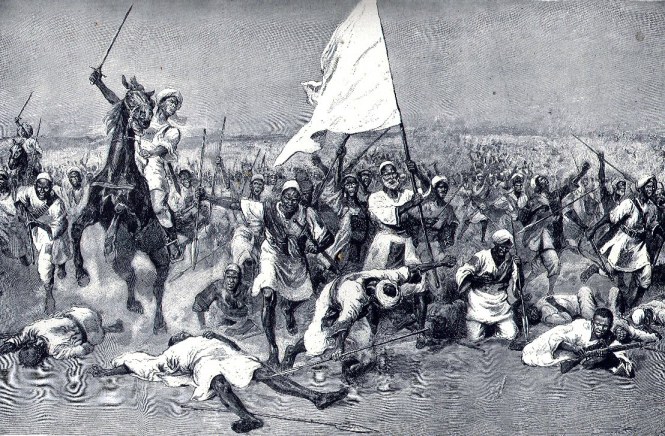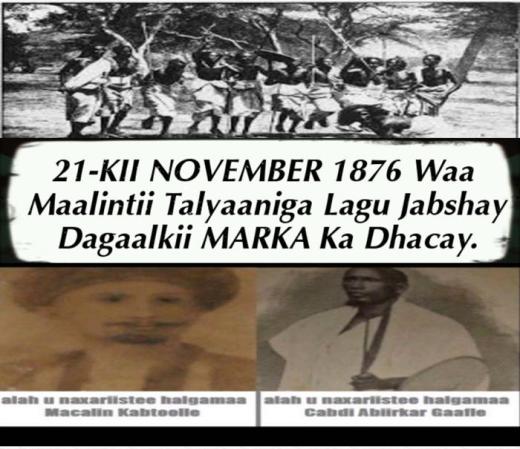This ancient shiekh was a Somali - prof. Andreski (the famous linguist) interviewed his descendant in Merca - the head of the main mosque is a direct descendant. Merca is a Somali town on the Indian Ocean (inhabited the Somali Dir clan). The custodians of the shrine/tomb of shiekh Hussein are Somalis - the tradional custodians have always been Somali. Again the role of Somalis in propergating Islam has never been recognised by Western Scholar? Why? Even the Maldive Islands off India rembere how the Somali Sheikh (13th century) called Shiekh. Awbarkhadle came and converted them - he is remembered in Somalia - and also appears in Arabic/Ethiopic MSS. in associating with the Walsama Dynasty (Muslim Dynasty eastern Shoa/Hawas - old Somali-Afar Sultans of Awfat/Adal) - Waqooyi Galbeed Holy shrine of Shiekh Hussein is an extremely impotant Islamic > centre - This ancient shiekh was a Somali - prof. Andreski (the famous > linguist) interviewed his descendant in Merca - the head of the main mosque is > a direct descendant. Merca is a Somali town on the Indian Ocean (inhabited the > Somali Dir clan). The custodians of the shrine/tomb of shiekh Hussein are > Somalis -

Tomb of the Saint
The town is named after what, in some Ethiopian Muslim eyes,
is the most sacred place in that country: the tomb of the thirteenth century
Somali saint called Sheikh Hussein, who introduced Islam to the Sidamo people
living in the area at the time, and is said to have performed many miracles. A
number of these miracles have been recorded in a hagiography published in Cairo
in the 1920s, entitled Rabi` al-Qulub. Although this town is now within the
homelands of the Oromo people, it has continued to be the destination of
approximately 50,000 pilgrims from Muslim Ethiopia twice a year during the
Muslim months of Hajj and Rabi' al-Awwal.[3] The first pilgrimage is to
celebrate his birth, the second his death. They traditionally carry cleft
sticks known as "Oulle Sheikh Hussein", which are too small to serve
as walking sticks and are not utilized for any practical purpose. Once they
arrive at the shrine, the pilgrims take their turns entering the saint's tomb
by crawling through a small doorway.[4]
The extensive religious complex dedicated to the saint
includes the town and the nearby valley of Kachamsare. In the 18th century,
Emir `Abd al-Shakur ibn Yusuf of Harar constructed a shrine to the Baghdadi saint
`Abd al-Qadir al-Jilani near the tomb of Sheikh Hussein, inside the shrine
compound. A graveyard has also been consecrated as part of the complex.[3]
Other landmarks of the complex include the pond of Dinkiro, 300 meters south of
the mosque, built in dry stone masonry; associated with the pond is a spring
with "miraculous" water. At the entrance of the holy area are two
wild fig trees called kiltu (identified as Ficus sycomorus) in the Oromo
language. Near another pond, of Imaro, there is the mosque of Sheikh Hussein's
father, both with a gubba of Harar type. Also nearby are several caves—a
"cave of serpents", a "cave of herbs", and a "cave of
honey"—and rock formations said to be petrified persons.[4]
Posted: Mon Sep 24, 2007 5:36 am Post subject: HOW ISLAM CAME TO SOMALIA AND ROLE DIR PLAYED
________________________________________
quote="Muddane Warsame"]E-mail Uu ii Soo Diray nin Direed (Surre)
qoraalada iga yaabshay oo uu dhalintaan ka qoreen islamka iyo doorka suuban ay Dir ka dheeshay fiditaanka Dinteena Suuban iyo fiqiyaasha Suure/
1)Qorahan waxaa uu sheegayaa in nin Direed oo looyaqaanya Sh. Yusuf Al Kownin ama ka weyne uu alifay qurmada Quraanka xafihiisa sida-- Alif la kor dhabee, La hosdhabe-- iyo higaada ku saleysan af keena hooyo ee Somaliga ah. Waxaa uu sheegayaa in xitaa magacayada Surre ee Fiqi (uu ka yimid Qareen diinta Islamka iyo Shareecada) madaama uu odeyga Surre ahaa wadad ku fidiyay Diinta Islamka oo uu wiilashiisa oo Fiqiyo ah u kala diray daafaha Somalia
HOW ISLAM CAME TO SOMALIA AND ROLE DIR PLAYED
According to our noble Dir brothers of Somalia. The eldest son and most ancient clan of the Somalis. 1) Islam came to Somalia in the first Hijra when the followers of the prophet fled to East Africa and came to Ethiopia as refugees. 2) So Islaam come to Somalia before Mecca was recaptured from the pagan Qurishi. The eldest Son of the Dir Ali madaxweyn who lived at this time around 643 Ad accepted the faith and sent a delegation to the Khilifa in 732-67 Ad. Shortly after that period even the illustrious Sheikh Ahmed (Mohamed Xiniftire studied in Yamen and returned to Somalia via the Dahlak Island where he fathered the Maxamed Xiniftire branch of the Dir which includes The Isaaq Axmed(Maxamed), Biyomaal maxamed ,Gadsan clans.
(Posted by guest: W.A)
reply
posted at Tue Feb 08 03:59:07 EST 2005 wax is weydiin
abdi taariikhda aad noo sheegtay waa taariikh xiiso leh ee tixraac maleedahay?
(Posted by guest: abraac)
Agoon History of Islam in Somalia from the Time of Mohamed (Saws)
Shortly after the Hijra (670's) the Quraish or prophet's tribe started persucuting muslims and hundreds of the prophets followers fled across the Indian Ocean to present day Zaila and through Erithrea.
It was in this period that the Somalis and their cousines the Afar-Oromo-Harararis and other nations of the horn of Africa converted to Islam.
According to most Historians the people of Zaila who were of Dir origin and Issas-Gadabursi-Isaaq origins, Islam became well established by 800 A.D. By the 1300 century the whole horn of Africa up to Kenya and Zanziber we have Muslim cities flourishing and Muslim sulltanes like Ifat and Adal all over Somali.
As a matter of fact, it was in 1300's that the ancient Somali Dir saint Sheikh Yusuf Alkownin (Aw Barkadle) innvented the Alif-La-Kordhabee or Somali way of reading and learning to read the Quran scriptures. And around this time, another Sheikh by the name of Sheikh Hussein Al Bale of the Bale Oromo Arsi region left Northren Somali and Islam was well established in Southren Ethiopia all the way to northren Ethiopia.
So the Islam of Somalia dates back to the time of the Hijra and many Somalis became muslims even before the Prophet Islamized the Arabs and Islam succeded in Arabia.
Later in he 1400 AD, the Qadiriya Sufi order of Sheikh Cabdul Qadir Al-Jilani spread to Somalia and Ethiopia revitalizing the ancient faith and further incorporating more Kushitics. The earliest leaders of Qadiriya Order were mostly from the saintly Dir sub-clan of Surre. The earliest Surre rulers were called Fiqis (Islamic Scholars of Diin and Lawyers of Sharia). The Oldest of the Surre clan the Qubeys and his younger brother, the Abdalles fathered some of the best Islamic Scholars in the 1600 century and they spread the Islamic faith all over the Somali coast. Imam Surre sent his numerous sons whom he named Fiqis to central Somalia, South, and North.
By 1456 AD, he Muslim Kings of Ifat, led by a Somali worrior, Imam by the name Imam Axmed Gurey (Left-Handed) was fighting Ethiopian Christian Habasha kings who tried to conquer Somalilands. W.A.
]E-mail Uu ii Soo Diray nin Direed (Surre)
Beelah Direed ee konfurta Somalia (Mudug/Galgaduud/Sh.Hoose) dagan waxa
ay sheegan in odeyga Direed uu dhalay Afar wiil oo kala ah:
Madaxeyne Direed oo curad ah, Mahe Direed oo ku xigeen ah, iyo labada
kale oo kala ah Madoobe Direed iyo Mandaluug Direed oo ugu yar da'a
ahaan marka la eego.
Taarikhiyan waxa ay rumeysanyihiin Dirka Galbeedka iyo Konfurta dagan
dhoor qodob oo ku saabsan tariikhda hore:
1)Dadka Direed in ay ka yimaadeen dhankan Galbeedka bilawgii, kunsano
ka hor.
2)Magaca Dir in uu macnahiisu yahay "Fir" ama Ab. Oo lagu macneyn karo
geesi ama Dhiire.
3)Konfurta Dirta dagan wexey rumeysan yihiin in ay Dirka xukumi jireen
Saladiin loo yaqiin ROOBLE oo ahaa ilaaliyaasha Xeerka iyo caadada
beesha.
Rooble- Xeerbeegti,Qareemo, amanduuleyaal,Roobdoonayal,iyo mareynta
reerka ayaa lagu aqoon jiray.Guud ahaana waxa ay ilaalin jireen xeerka
oo Dirku rumeysnaa in ay ka dhaxleen Dir Aji abkoodi hore.
Madaxdan oo loo aqoon jiray Roobleyaash dadku wey ixtiraami jireen ila heer xitaa
isha laguma godi jirin, oo xitaa "ILKULULe" ayaa loo aqoon jiray.
4)Waxa kaloo ay rumeysan yihiin in Zeylac magalada la yiraahdo ay Dir
badan soo jidatay qarnigii (700 AD) halkaas oo ay ka soo dageen Asxaab
badan oo Rasuulka(Caleyhi salatu wa salaam) u soo diray magaalada
Zailac Hijradii koowad. Oo dadka Direed iyo Canfarta (Oday Caliga) ay
waagii danbe ka wada asaseen labo boqortooyo oo la kala dhihi jiray
CIFAT iyo CAdal.
5)Dirta koonfurta iyo Galbeedka dagan waxa ay rumeeysan yihiin oo kale
in 1400 ay dhaceen dagaalo far badan oo xabashida iyo muslimiinta is
dagaaleen. Ilaa ay xabashida oo adeegsaneysa (Portugees)burtaqiis ay
cagta mariyeen boqortooyoyinkii Musliminta oo kuwa Direed ee Cifat iyo
Awda ka mid ahayeen
6)Dhamaan waxa ay rumeysan yihiin Dirka in ay door weyn ka ciyaareen
fidinta diinta Somalia iyo Ethiopia dhexdooda.
Sheekhyada waaweyn ee geeska Afrika sida Sheikh Xuseen Bali, Aw
Barkadle, Awbarre iyo qaar kale ay Cadal iyo Cifad ka soo jeedan
4)Beelaha Biyomaal iyo Suure iyo Guure waxa ay sheegan in 1600-1750 ay
u soo guureen duleedka dalka (Gobalada dhexe iyo labada wabi dhexdooda)
mudo yar ka dib dagaladii Axamed Gurey iyo Amxaarada.







''With government approval, Cecchi prepared for an expedition into the interior. By November 25, he was ready to move; his caravan consisted of seventy askaris, Commander Ferdinando Maffei of the Staffetta, Commander Franscesco Mongiardini of the Volturno, and fourteen other Italians, for the most part members of the crews of the two ships. That very night their encampment at Lafolé, some twelve miles inland, was attacked. In the early morning hours, as the caravan once more got under way, it was attacked again. By eight-thirty in the morning of November 26, all but three sailors were dead or dying.''
''First Adowa, then Lafolé; the future of Italian colonialism in the Horn of Africa looked very umpromising at the end of 1896''
Italian Colonialism in Somalia, Robert L. Hess 1966.
-----------------------
This event sparked one of the longest resistance struggles in Southern Somalia (Benadir) against Italian penetration and occupation of Somalia. This long resistance is only second to the heroic great struggle of Sayyid Muhammed Abdulle Hassan and his darawish army.
What happened on that day of November 25-26th of 1896? Who was this Cecchi guy? Who were these mysterious warriors that swiftly defeated this first Italian colonial penetration of the hinterland of Benadir? Why is this event put in the same line as the humiliating defeat of the Italians by Ethiopians in Adowa? And last but not least, what were the consequences of this event in Lafole?
This episode in Somali history is perhaps the least known, although it had crucial impact on the future of Somalia. Instead, most Somalis are not aware of this event while the Italians had built a monument for Antonio Cecchi in Lafole which still stands in the bush unvisited, while throughout the Banaadir 1896 is remembered in the count of the years as Axad Shiiki, the ‘Sunday Year of Cecchi’.
To present an elaborate account of this event, we need to start with the context. Who were the main groups in the Benadir region? Who was Antonio Cecchi and what was his role in the Italian expansion into Somalia? And what were the consequences of this event both for Somali groups and Italy?
In a number of series I'll present the complete story, and show why this event and the shockwave it send throughout Benadir and Southern Somalia is still relevant to this day.
The Bimaal were instrumental in mobilizing the Somali Tribes in the south and Formed an alliance with the Darvish movement instilling Fear in the Italian Governor Carletti
In June 1908 Governor Carletti wrote to the Ministry of Foreign Affairs:We cannot afford to delay our move inland, since it will be difficult to occupy the river when the rebels who left over two months ago return with guns from the Mullah Muhammad
To give added weight to his pleas for decisive government action, Carletti attached a letter from the sultan of Geledi written earlier that month:
The Biimaal have abandoned their territory and the major part—around 4000—are in voyage to the Mullah. Only the old men, women, and children remain. Even among the Hintire only a few remain…. You must make war without any delay. Don’t remain inactive…. Your enemies won’t obey your orders and say, “We will obey only Shaykh Muhammad Abdullah….” Hintire, Biimaal, Wacdaan, Jambelul, Daud, and Mobilayn amount to more than 100,000 [ sic ]. If their messengers return with arms, they will all stand against us and the territory will be lost, since they desire only war
While the letter almost certainly exaggerates the number of Somalis who actually left to contact the mullah in the north, it does give an idea of the extent to which the resistance had become pan-tribal. A united resistance is precisely what the colonials feared.
Therefore, in August 1908, auxiliary soldiers under Italian command marched inland to the Shabeelle. They raised the flag at Bariirey; they fought with valiant Somalis for several hours outside of Mereerey; then their forces marched triumphantly into Afgooye. The colonial occupation of the interior had begun, prompted by the events of the “Year of the Dervishes.”
Source:
Page 250 of Lee Cassanelli’s The shaping of Somali society: reconstructing the history of a pastoral people, 1600-1900
The Biyamaal arrived in the Lower Shabelle around the end of 17th century and established control over Merca and the hinterlands. The Biyamaal were in constant war with the Geledi Sultanate, and even killed 2 Sultans of Geledi through out the war.